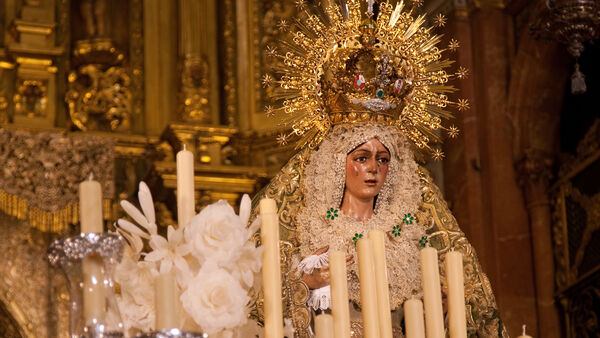Sevilla’s Favorite Virgin
By Rick Steves
Sevilla's Holy Week (Semana Santa) celebrations are Spain's grandest. During the week leading up to Easter, the city is packed with pilgrims witnessing 50 processions carrying about 100 religious floats. If you're here outside that week, you can still get a feel for this event by visiting the Basílica de la Macarena (built in 1947) to see the two most impressive floats and the darling of Holy Week, the Weeping Virgin (Virgen de la Macarena, a.k.a. La Esperanza).
This Mary comes complete with crystal teardrops — she's like a 17th-century doll with human hair and articulated arms, and even dressed with underclothes. Her beautiful expression — halfway between smiling and crying — is moving, in a Baroque way. Her weeping can be contagious; visitors who come to view her are often moved to tears. Filling a nearby side chapel is the Christ of the Sentence (from 1654), showing Jesus the day he was condemned.
The two most important floats of the Holy Week parades — the floats that Mary and Jesus ride every Good Friday — are also in this church, parked behind the altar (these require a museum ticket to see).
The three-ton float that carries Jesus is slathered in gold leaf, and shows a commotion of figures acting out the sentencing of Christ (who's placed in the front of this crowd). Pontius Pilate is about to wash his hands. Pilate's wife cries as a man reads the death sentence. While pious Sevillan women wail in the streets, relays of 48 men carry this float — with only their feet showing under the drapes — as they shuffle through the streets from midnight to 2 p.m. every Good Friday.
La Esperanza follows the Sentencing of Christ in the procession. Mary's smaller (1.5-ton) float, in a nearby room, seems all silver and candles — "strong enough to support the roof but tender enough to quiver in the soft night breeze." Mary has a wardrobe of three huge mantles worn in successive years, and each is displayed here. The big green one is from 1900. Her six-pound gold crown/halo (in a glass case in the wall) is from 1913. This float has a mesmerizing effect on the local crowds. People line up for hours, clapping, weeping, and throwing roses as the float slowly works its way through the city. My Sevillan friend explained, "She knows all the problems of Sevilla and its people. We've been confiding in her for centuries. To us she is hope. That's her name — Esperanza."
The museum area also has a case of matador outfits, which were given to the church over the years by bullfighters, in thanks for the protection they feel they received from La Macarena. Considered the protector of bullfighters, she's big in bullring chapels. In 1912 the bullfighter José Ortega, hoping for protection, gave her the five emerald brooches she wears. It worked for eight years...until he was gored to death in the ring. (This was such a big deal that La Macarena was dressed in black afterward — the only time that has happened.)
Outside the church you can see the best surviving bit of Sevilla's old walls. Originally Roman, what remains today is 12th-century Moorish, a reminder that for centuries Sevilla was the capital of the Moorish kingdom in Iberia. And yes, it's from this city that a local dance band (Los del Río) changed the world by giving us "The Macarena."


